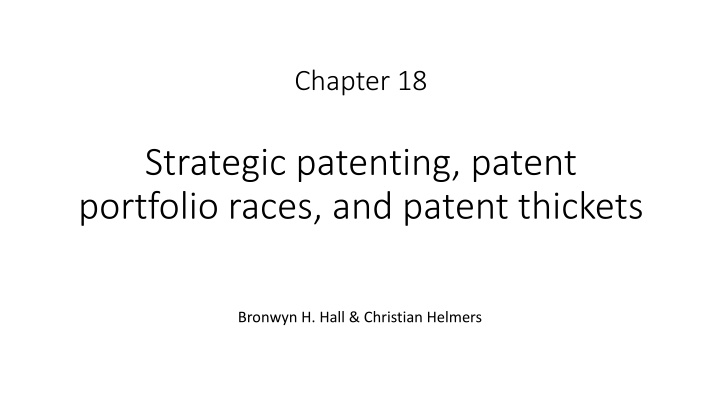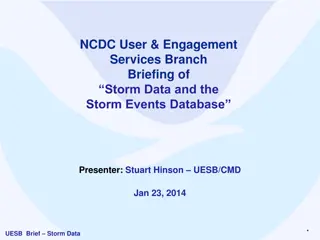Storm Sewer System Design Considerations and Solutions
The design of a storm sewer system involves assessing the amount of storm sewage to be carried, considering rainfall data, and utilizing the rational method for runoff estimation. This preliminary design process includes determining the time of concentration and flow paths within the system. Various equations and solutions are employed to design an efficient storm drainage system. Explore an example and solution for designing a section of a storm sewer system based on provided data.
Download Presentation

Please find below an Image/Link to download the presentation.
The content on the website is provided AS IS for your information and personal use only. It may not be sold, licensed, or shared on other websites without obtaining consent from the author.If you encounter any issues during the download, it is possible that the publisher has removed the file from their server.
You are allowed to download the files provided on this website for personal or commercial use, subject to the condition that they are used lawfully. All files are the property of their respective owners.
The content on the website is provided AS IS for your information and personal use only. It may not be sold, licensed, or shared on other websites without obtaining consent from the author.
E N D
Presentation Transcript
Chapter 18 Strategic patenting, patent portfolio races, and patent thickets Bronwyn H. Hall & Christian Helmers
Overview Introduction: Strategic use of patents. Competitive advantages generated by strategic patenting. Strategic patenting in information and communication technologies Different strategic motives for patenting Consequences of strategic patenting: ownership fragmentation and patent thickets 2024 Hall & Helmers Ch. 18 2
Introduction Standard introductory microeconomics textbooks treat patents as a way for firms to obtain temporary exclusivity. In most simplistic framework, innovation is a process innovation that lowers innovator s marginal cost from c to c where c>c . Patent prevents other companies from also lowering their marginal costs to c by adopting same technology and hence affords the innovator a temporary monopoly. Reality is a lot more complex. 2024 Hall & Helmers Ch. 18 3
Introduction Primary use of patents as legal tool to deter copying and to achieve exclusivity. In pharmaceuticals, single patent on active ingredient can prevent market entry by competitors and secure exclusivity. In reality, new drug protected not by one, but dozens of patents that cover range of related aspects. Helps prevent outright copying of drug for longer than the life of the original active ingredient patent, and makes it more difficult for competitors and generic producers to come up with alternative versions. Patents serve their conventional function of ensuring exclusivity, but also serve a strategic function. 2024 Hall & Helmers Ch. 18 4
Introduction Strategic in pharmaceutical example means that a company treats a patent as an asset, used to gain a competitive advantage that goes beyond the exclusivity that it would obtain if the patent protected its drug through a single active ingredient patent. Key to understanding the strategic use of a patent: Additional competitive advantage conferred by the patent above and beyond the standard exclusivity granted by patent protection. If you only use your patents to protect your products [ ] you re missing all manner of revenue-generating and other opportunities (Jan Jaferian, former vice president of IP at Xerox). 2024 Hall & Helmers Ch. 18 5
Introduction Apple s US 8,046,721 Unlocking a device by performing gestures on an unlock image A method of unlocking a hand- held electronic device, the device including a touch-sensitive display by continuously moving the unlock image on the touch- sensitive display (Claim 1) 2024 Hall & Helmers Ch. 18 6
Introduction Asserted in Apple v. Samsung Electronics Jury found in 2014 that several of Samsung s devices infringed on swipe-to-unlock patent. Swipe-to-unlock patent was only one for which it also found willful infringement Jury awarded Apple a total of nearly US$120 million in damages 2024 Hall & Helmers Ch. 18 7
Introduction Swipe-to-unlock patent helpful in Apple s litigation campaign. Primary objective of patent most likely to guarantee Apple exclusivity over the swipe gesture to unlock a touchscreen. Swipe-to-unlock patent gave Apple additional strategic leverage in its dispute with Samsung. Patents can serve as both legal and business assets. Focus of strategic patenting is on extracting additional value from treating patents as business assets. 2024 Hall & Helmers Ch. 18 8
Introduction Literature identified range of strategic motives for patenting by firms that are distinct from traditional motive to protect from imitation. Offensive and defensive blocking most important strategic motives to patent. Patents also considered important for reputation, bargaining and generating licensing revenue. 2024 Hall & Helmers Ch. 18 9
Strategic patenting in information and communication technologies (ICT) Rapid increase in patenting propensities in semiconductors beginning in the second half of the 1980s. Patenting propensity defined as ratio of number of patent grants to average of the prior three years R&D expenditure (measured in real US$ millions). Until then, patent system had been considered largely ineffective for appropriating returns to innovation outside of pharmaceuticals and chemicals. 2024 Hall & Helmers Ch. 18 10
Explanations for increase in patenting propensity: Institutional strengthening of U.S. patent system due to creation of U. S. Court of Appeals for the Federal Circuit (CAFC). High-level court cases that increased value of patents for firms: In 1986, a court awarded Polaroid US$ 1 billion in damages against Kodak and imposed a permanent injunction. Reinforced perception that patent owners were likely to prevail in court and obtain considerable damages or injunctions against competitors. Number of large players in the market, such as Texas Instruments, AT&T, and IBM had begun to license more aggressively to increase monetization of patent portfolios: Texas Instruments had successfully asserted a number of patents on integrated circuits against Japanese and Korean competitors. Successful lawsuits allowed Texas Instruments to charge higher royalties also to domestic licensees. To some extent firms became more productive in terms of translating a dollar of R&D into innovation output protected by patents. Still, increase puzzling because it occurred in an industry where firms often reported patents to be ineffective and to be less important for appropriating returns to R&D: Patent Paradox (Hall and Ziedonis, 2001). 2024 Hall & Helmers Ch. 18 11
Patent Paradox Main explanation for the patent paradox: increased use of patents for strategic purposes. Capital-intensive firms vulnerable to hold-up due to large sunk costs required in complex manufacturing. As a reaction, expanded patent portfolios to engage in cross-licensing and deter lawsuits by having a credible threat to countersue. Evidence from interviews with semiconductor firms (Hall and Ziedonis, 2001): Firms changed their perception of the role that patents played in their corporate strategy; Increased usage of language by managers like harvesting latent inventions reflecting a deeper reach into an existing pool of inventions rather than a shift in R&D activities per se (Hall and Ziedonis, 2001: 108). Change in perception of importance of patents for defensive purposes led to important changes in the way firms managed their intellectual property. Firms increased patent filings for a given level of innovation output. 2024 Hall & Helmers Ch. 18 12
Patent Portfolio Race Using data on a large sample of U.S. semiconductor firms for the period 1975- 1998, Hall and Ziedonis (2001) showed that the increase in patent filings per dollar of R&D was indeed driven by strategic motives: Standard predictors of patent filings, above all R&D investment and firm size, explain patent filings well until mid-1980s. Towards late 1980s and early 1990s, R&D spending could no longer explain patent filings. Patent filings appeared to be driven by capital intensity and more importantly, a large component of variation in patent filings could no longer be accounted for by any standard firm characteristics. Combination of observed substantial increase in patent filings by firms and fact that it could not be accounted for by standard predictors of patent filings lead to the conclusion that patent filings must have been driven by strategic motives. Hall and Ziedonis (2001) called this phenomenon Patent Portfolio Race . Since the early 1990s, strategic patenting has increased dramatically and spread far beyond the U.S. semiconductor industry to the entire ICT sector. 2024 Hall & Helmers Ch. 18 13
Netflix and the changing importance of patents Online streaming service Netflix founded in 1997. Initially, Netflix offered a DVD mail- rental service. Company went public in 2002 In 2007, Netflix made major technological leap by starting to stream video content on demand. Neflix s revenue grew at exponential rate between 1998 and 2019, from slightly more than US$ 1.3 million in 1998 to over US$ 20 billion in 2019. 2024 Hall & Helmers Ch. 18 14
Netflix and the changing importance of patents No patents during first few years and only very modest number, one or two annually. Filing behavior changed: Increased technological complexity of Netflix s business . Patent infringement lawsuit brought against leading competitor Blockbuster in 2006. Netflix s complaint allege[d] that Blockbuster willfully infringed U.S. Patent No. 7,024,381 Approach for Renting Items to Customers and U.S. Patent No. 6,584,450 Method and Apparatus for Renting Items . Lawsuit ended with settlement in 2007 and payment of US$ 7 million by Blockbuster. Market entry of competitors in streaming market, such as Hulu, launched in 2007, or HBO Go, launched in 2010. Increase in patent infringement lawsuits targeting Netflix. Companies that create new products or even entire new markets often forgo patent protection at early stages of their development. As competition intensifies and company grows, patents become more valuable from a strategic perspective. Rapidly growing patent portfolios used to generate a competitive advantage for maturing company. 2024 Hall & Helmers Ch. 18 15
Strategic patenting Firms across industries engage in strategic patenting. Konica Minolta states in its 2021 IP report that [ ] an intellectual property strategy tied closely to business strategy and technology strategy is an essential element for management. Company created a formal Intellectual Property Strategy 2017-2022 with the express goal of supporting the company s business model through strategic use of IP. 2024 Hall & Helmers Ch. 18 16
Forms of strategic patenting: bargaining Most common strategic use of patents is for bargaining purposes Different purposes: Patents can directly generate new or increase existing revenue streams. Patents can reduce costs by enabling access to other firms patents without requiring any monetary compensation through cross-licensing agreements. Patents facilitate establishing business partnerships with competitors or upstream/downstream firms involving the joint development of new technology or products. Occurs in the shadow of litigation and patents can help manage any resulting legal risk. 2024 Hall & Helmers Ch. 18 17
Forms of strategic patenting: Offensive/defensive blocking Blocking used as offensive strategy: block competitors from pursuing certain directions of research or product development. Patent similar, substitute technologies to make it harder to invent around their patented technology. Even if company does not pursue the substitute technologies for its own production, it can still create obstacles for competitors. Blocking is used as defensivestrategy: ensure a company s own freedom to operate. Ensure that future research and product development paths are not blocked by competitors. Ensure a company s ability to commercialize its own technology. 2024 Hall & Helmers Ch. 18 18
Forms of strategic patenting: Offensive/defensive blocking Implemented through a range of specific strategies: Blanketing or flooding: firm files large number of patents around a competitor s (patented) technology to limit competitor s freedom to operate. Fencing or clustering: similar, primarily defensive strategy, where innovator patents not only core invention, but also specific related and in particular substitute technologies to limit a competitor s ability to invent around. Outcome sometimes described as a patent wall (Rivette and Kline, 2000). Surrounding or bracketing: shield core technology by patenting around it by for example patenting different applications or uses of core technology. Networking: patents are combined in a portfolio with express goal of increasing protection beyond what individual patents can achieve. 2024 Hall & Helmers Ch. 18 19
Forms of strategic patenting Reputation:Shape firm s public perception and reputation. Reinforce the public perception that operate at the technology frontier by highlighting number of patent filings. Mercedes Benz advertised its E-Class series in a TV commercial by highlighting that it held over 80,000 patents. Among competitors, create a reputation for aggressively protecting one s innovation and if necessary enforcing it in court Investment: Attract outside investment, especially for early-stage companies. Use patents as credible signal targeted at outside investors. Allow investors to recoup some of their investment in case a venture fails. Technology diffusion and standards: control over technology in form of patents may help companies influence technology adoption and diffusion. 2024 Hall & Helmers Ch. 18 20
Forms of strategic patenting Strategies can be achieved by different means: Adjust their own patenting decisions, decide whether to patent a given invention, and how to craft the corresponding patents. Sell or acquire patents from other entities. Range of other mechanisms available to strategically share and exchange patents. Offensive use of patents may require credible threat of enforcement. Strategic patenting poses managerial challenges: Requires active management of patents. Management of patent portfolio becomes responsibility of not only legal counsel but a firm s (top) management. Potential need for formal IP management. Formulate and implement patent strategies. 2024 Hall & Helmers Ch. 18 21
Consequences of strategic patenting Strategic use of patents creates value for combinations of patents even when individual patents are of little value by themselves, which increases company s profits. True for pharmaceutical industry but also applies to other industries that are characterized by strategic patenting. Example of Gillette Fusion Power razor: 22 interlocking patent families protect Gillette Fusion Power razor. Interlocking characteristic of patent portfolio successfully prevented competitors from imitating most important features (Sternitzke, 2017). John Bush, former vice-president of R&D at Gillette: We patented the key design features in the cartridge, the springs, the angle of the blades [ ]. There were also patents covering the handle and some of its characteristics. We even patented the container that had the proper masculine sound and feel as it was ripped [ ]. We created a patent wall with those 22 patents. And they were all interlocking so that no one could duplicate the product. (quoted in Davis and Harrison, 2001). Strategic patenting also generates negative externalities: Patent portfolio races. Increase transaction costs. 2024 Hall & Helmers Ch. 18 22
Ownership Fragmentation and Patent Thickets Strategic patenting can lead to increase in fragmentation of ownership of technology, especially in complex and modular technologies. Fragmentation of ownership means that different patents that protect distinct components of a complex product are owned by different parties. To make the product, access to these patents has to be obtained from all the different parties. Increased fragmentation of any associated patent rights may increase transaction costs for market participants. Fragmentation of patent ownership can prevent use of underlying patented technology because transaction costs associated with bargaining among the different patent owners becomes prohibitively costly---a situation described as anti-commons (Heller and Eisenberg, 1998). When patent ownership is fragmented, individual rights holders are likely charging too high a royalty because of the Cournot complements problem. 2024 Hall & Helmers Ch. 18 23
Ownership Fragmentation and Patent Thickets In the presence of technological complementarity, fragmentation of patent ownership can result in a patent thicket. Patent thicket is a dense web of overlapping intellectual property rights that a company must hack its way through in order to actually commercialize new technology (Shapiro, 2001: 120). Thickets occur when different patents cover the same technology and hence overlap. Fragmentation fosters the emergence of thickets, but thickets can occur even in technologies with more concentrated patent ownership as long as there are overlapping patent claims. Thickets can restrict a company s freedom to operate even when the company holds patents on its own technology. Both fragmentation and thickets are subject to a self-reinforcing mechanism. Due to strategic complementarity, patenting by one firm raises the incentives for all other firms to patent. This increases fragmentation of technology ownership. As ownership becomes more fragmented, it increases overall level of patenting as firms have strong incentives to accumulate large defensive patent portfolios. In presence of overlapping claims, increased fragmentation exacerbates formation of thickets. 2024 Hall & Helmers Ch. 18 24
Measuring fragmentation and patent thickets Different approaches to measuring ownership fragmentation and thickets: Count number of granted patents within a defined product market or technology field (Cockburn and MacGarvie, 2011). Measure fragmentation based on backward patent citations (Ziedonis, 2004) : 2 1 where i j i NBCITES = NBCITES J ij = Frag i j 1 NBCITESi denotes number of backward cites made by patents issued to firm i in a given year, NBCITESij denotes the number of backward cites made to firm j by patents issued to firm i. 4-firm fragmentation measure (Noel and Schankerman, 2013) : 1 with it ijt j = 4 = Fragcite s i j 1 where sijt denotes the share of total number of citations by firm i that refer to patents held by firm j, cumulated up to year t. Captures the share of backward cites by firm i that are accounted for by top four firms that hold patents cited by firm i. 2024 Hall & Helmers Ch. 18 25
Patent thickets Von Graevenitz et al. (2011) proposed measure that captures overlapping claims. During examination process, patent examiners produce search reports in which they list all relevant prior art. At EPO, X/Y marker identifies overlap between prior patents and the patent under examination. Measure by von Graevenitz et al. exploits this information to identify blocking relationships between patents. Triple measure captures whether there are three firms that hold patents that block each other due to overlapping claims. 2024 Hall & Helmers Ch. 18 26
Patent thickets 2024 Hall & Helmers Ch. 18 27
Consequences of ownership fragmentation and thickets Clear theoretical prediction: development process of complex technology is cumulative, blocking patents in the form of thickets adversely affect innovation (Shapiro, 2001). Robust evidence to suggest that patenting levels are positively associated with thickets (Ziedonis, 2004; von Graevenitz et al., 2013). Patenting levels reduce product market and technology entry (Lerner, 1995; Cockburn and MacGarvie, 2011). Evidence on impact of thickets on technology entry of firms (Hall et al., 2021): Thickets affect entry by firms into new technology areas as measured by first-time patenting across a wide range of industries in the UK. Thickets raise entry costs which could adversely affect innovation more broadly if more radical inventions come from entrants rather than incumbents. Evidence for publicly traded firms of a positive effect of patent thickets on litigation and a negative effect on new product launches and firm profitability (Hu et al., 2022). 2024 Hall & Helmers Ch. 18 28
Summary Strategic patenting: use of patents by firms as business assets to gain competitive advantage beyond the traditional purpose of a patent to exclude competitors from use of the patented technology. Strategic patenting widespread, especially in the ICT industry and motivated by a wide range of diverse goals that go beyond purely defensive motives. Strategic patenting results not only in increased patenting levels, but also leads to fragmentation of patent ownership. Fragmentation can create thickets, which reinforce need for strategic patenting and which may adversely affect technology entry and innovation more broadly. 2024 Hall & Helmers Ch. 18 29























